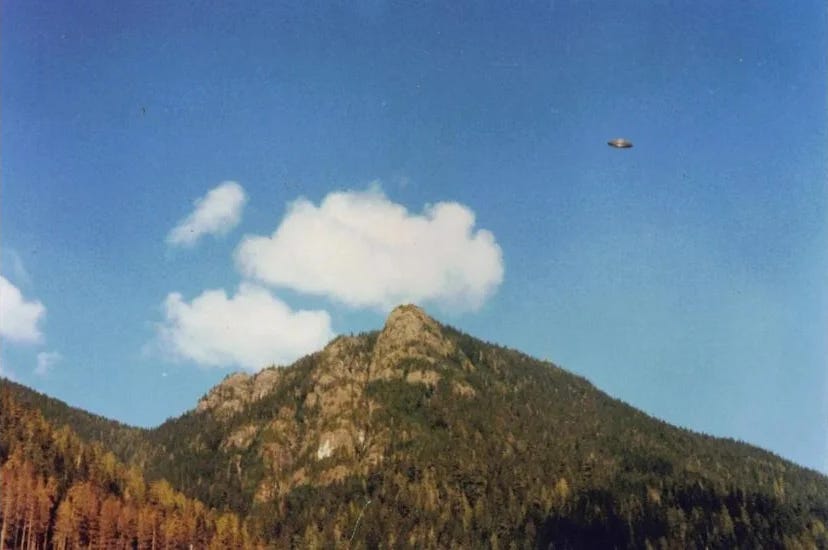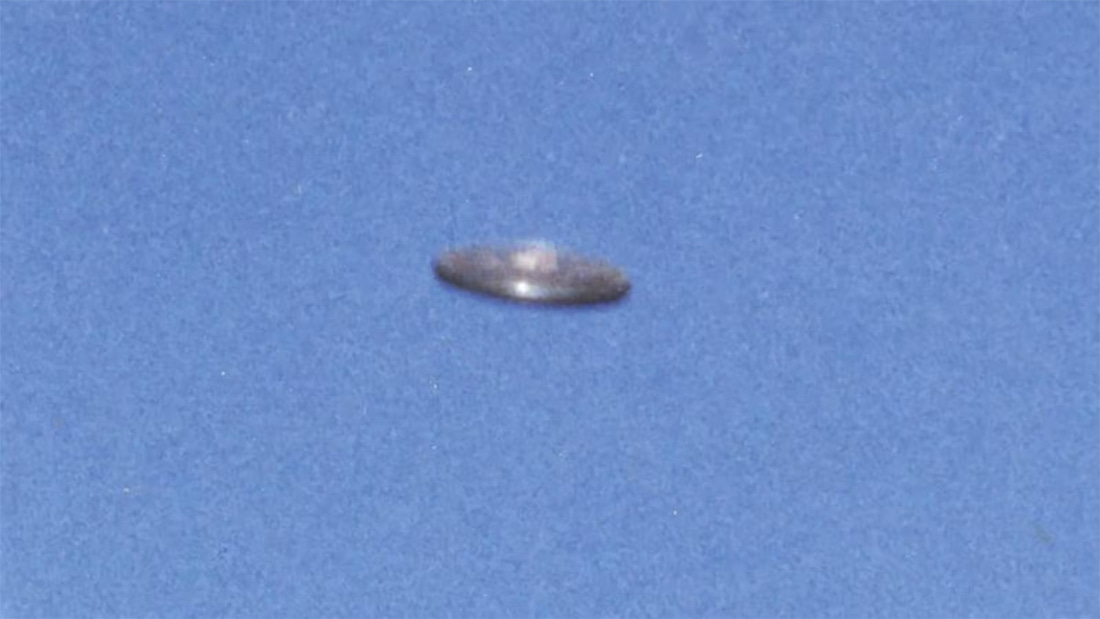Sky Canada Project 2
Chief Science Advisor of Canada calls for federal effort to "manage" UFO reports
A study led by Mona Nemer, chief science advisor to the government of Canada, recommends her nation establish a new agency to collect, analyze and share UFO sightings. The Sky Canada Project study recommends that nation institute a new body to gather sighting reports from public and private individuals and institutions across the nation. The agency would be dedicated to the study of UAP, applying the scientific method to the study of anomalous aerial phenomena. The new office would share its progress and significant sightings with the people of Canada annually.
The photograph above was taken by Hannah McRoberts during a visit to Vancouver Island, British Columbia, Canada in 1981. The photographer wanted to image “an unusual cloud,” only later discovering the UFO at top right after the film and photographs returned from the processing lab. A close-up of the image is below:
The thing looks like a flying saucer. Of course, there may be another explanation.
A report from journalist Bryce Hoyce of the CBC follows directly below, along with links to the complete report and one-page brief on the rationale for scientific approach to the UFO phenomenon.
Canada needs agency to manage public UFO sightings, says new federal report
Federal mechanisms for UFO reporting 'fragmented,' says report commissioned by office of chief science adviser
by Bryce Hoyce
CBC News, July 17, 2025Canada needs a transparent, public-facing agency in charge of managing reports of mystifying things seen darting, blinking or hovering through our skies, according to a new report commissioned by Canada's top scientist.
The Sky Canada Project report published this week calls for a federal framework for managing UFO sightings by the public and pilots as a replacement for the current patchwork of protocols across departments that "hinder[s] scientific investigation."
"There is some evidence that there's something really unusual going on in the skies.… We just don't have enough information," said Winnipeg-based science writer Chris Rutkowski, director of the long-running Canadian UFO Survey, who was consulted for the report.
Snip...
The report also identifies the need to increase transparency and build public trust through proactive disclosure of UAP case details in an effort to combat misinformation and disinformation, and "pre-bunk" conspiracy theories before they spread.
The Residium editor agrees with the approach of the Canadian Science Advisor:
How the Scientific Method Might Apply to UAPs
The scientific method is a systematic and iterative process used to investigate the universe around us, acquire new knowledge and refine or correct existing understandings of the world. Applying it to UAPs could involve several key steps, including:
Observation: Gather reports and data on UAP sightings, including, but not limited to, eyewitness accounts, photographs and videos, radar data and physical evidence, ensuring that the information collected is objective and unbiased. This may include developing new instruments specifically designed to enhance the accuracy and reliability of the data.
Hypothesis: For each case under investigation, explore possible explanations for the sighting. This could range from natural phenomena to advanced human-made technology and may include fraud and instrument malfunction.
Experimentation: Test the hypothesis. While traditional experiments might be challenging due to the elusive nature of UAPs (the sighting cannot be repeated like an experiment in controlled laboratory conditions), researchers may conduct simulations, analyze existing or past data, or use observational tools (like radar or satellites) to gather additional information.
Analysis: Review and analyze the data to look for patterns, anomalies or correlations. This might include comparing UAP reports with known atmospheric phenomena or the behaviour and flight path of aircraft.
Conclusion: Draw conclusions based on the analysis. This could involve categorizing a given UAP into known phenomena, unexplained sightings due to lack of data, or areas needing further investigation.
Communication: Share findings with the scientific community, government agencies and the public, through research papers, or reports and through a publicly accessible online portal.
Applying the scientific method to UAPs makes it possible to ensure a rigorous and objective approach to understanding these phenomena while promoting critical thinking and advancing scientific knowledge.
The following is a report from Chris Rutkowski, the Canadian ufologist instrumental in gathering more than 24,000 reports from across Canada over the past 30 years-plus through the annual Canadian UFO Survey.
Why We Should Take UFOs Seriously
Whether you call them UFOs, UAPs or flying saucers, Canada should treat the objects that fly in our skies as scientific phenomena, not pop-cultural quackery
by Chris Rutkowski
MacLean’s, October 20, 2023Excerpt…
Canada should establish a central repository where new UFO reports can be collected and analyzed. Every year, that office should produce a public report, much in the same way the Supreme Court of Canada releases its annual year in review. This summary should include sightings from civilians—farmers, birdwatchers, even accountants who happen to glance upward during their daily commute. Science has always been advanced by the observations of regular people.
The broader scientific community will also need to participate in UFO studies to provide Canadians with proper data. There’s already good news on this front. This past September, NASA released a 33-page report that called for better UFO data gathering, possibly aided by AI technology and open-source smartphone apps. Also earlier this year, news broke that Canada’s Office of the Chief Science Advisor had launched the Sky Canada Project, the Canadian government’s first known UFO research effort in three decades. The goal is to examine how UFOs are tracked in Canada. (The results are expected in 2024.) These developments open the door for the use of scientific tools, like video surveillance, remote-sensing technology and telescopes. They can help us identify what we see, and also answer questions like how long it was there and how it moved. Scientists like tangible, replicable data, not anecdotes. These tools could provide it.
I’d like to see Canadian post-secondary institutions include more UFO-focused coursework in their disciplines—and not just in astronomy. Engineers, for example, could speculate on the technical details of how interstellar travel might work. There’s been some UFO research at Canadian universities, like the University of Toronto’s Institute for Aerospace Studies. But for the most part, ufology—the study of UFOs—has remained within the “invisible college,” among scientists who’ve conducted research for interest’s sake, without institutional support.
There’s also the issue of misinformation: when scientists dismiss the validity of studying UFOs, Canadians don’t become less fascinated by them. We’re just forced to settle for less-reputable, fringe sources of information. (One Sky Canada document, for example, lists “preventing conspiracy theories” as a priority.) We get caught up in the wild speculation on Reddit or X, or watch Encounters, Netflix’s new and popular (but incomplete) UFO docuseries. Pop-cultural touchstones, like Star Trek and Unsolved Mysteries, feed our fundamental desire to know whether or not we’re alone in the universe. But the civic duty of scientists is to give us the facts.
It is most heartening to know that our family, friends and allies in Canada are interested in studying the UFO phenomena scientifically and democratically. Here’s to seeing the day when We the People of the United States do so, as well. — The Residium




